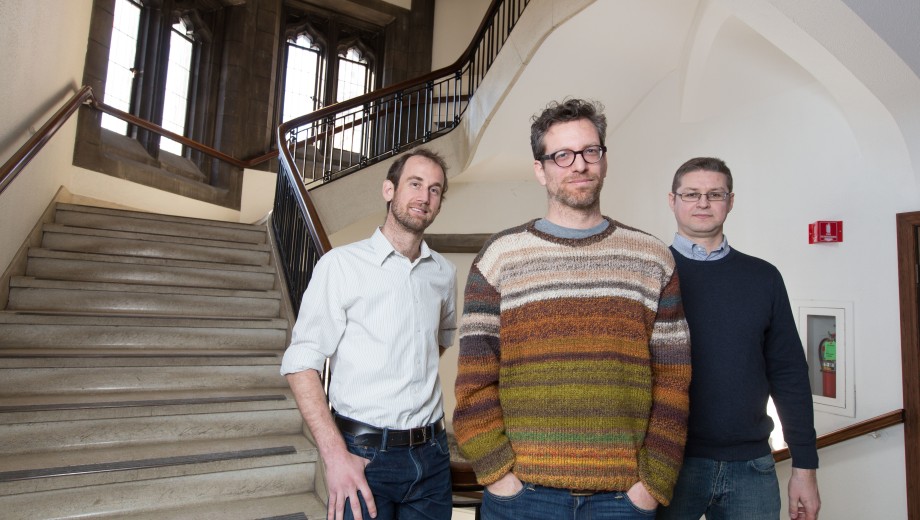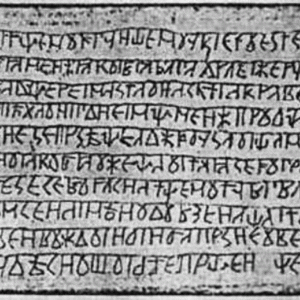Founded in the mid-1930s, UChicago’s Department of Linguistics is one of the oldest in the United States. And while departments change based on the people who populate them, the program remains “very much in line with its history,” says professor and chair Chris Kennedy. Two of the University’s earliest linguists, Leonard Bloomfield and Edward Sapir, studied indigenous languages in the Americas, says Kennedy, “while asking the same types of questions about the nature of language that we’re asking now.”
That enduring combination of theory and detailed attention to particular language families—their structure, history, culture—distinguishes UChicago’s Department of Linguistics. The program’s breadth and depth of study give the faculty room to approach their research with varied perspectives and methods. The department has “several different ongoing clusterings,” says Kennedy, with many faculty members working in more than one. The assistant professors, who collectively span several of these clusterings, all bring their own expertise in trying to answer the questions asked by early UChicago linguists.
What do we know?
Assistant professor Itamar Francez is part of one such cluster that underlies the others: formal theoretical linguistics, which involves creating linguistic models in terms of grammatical principles. The formal perspective presents language as shaped by certain structural features, rather than from the way speakers use it—a functional perspective.
Francez is a formal semanticist: a linguist who studies meaning while using “mathematical or logical tools. “I work on the way meaning influences the formal shape of languages, and the way meaning plays a role in determining how languages can vary from each other.” Francez, who joined the department in 2012 and is a fellow this year at the Franke Institute for the Humanities, also studies Hebrew grammar and pragmatics, the relationship between meaning and use.
In his research Francez asks, “What do native speakers know when they know a language?” Native speakers have an internal system of rules that helps them associate meaning with complex expressions, even if they have never heard the expression before. They don’t simply memorize meanings of terms; they have a “generative way of assigning meaning.” The field of semantics, where Francez’s research lies, is engaged in articulating a theory that explains what this knowledge is and how it makes this attribution of meaning possible.
How do we know what we know?
Francez calls himself a “couch linguist,” compared to an experimentalist like assistant professor Ming Xiang. Director of the Language Processing Laboratory, one of four labs in the Karen Landahl Center for Linguistics Research, Xiang was recruited in 2010 to strengthen the department’s experimental linguistics cluster. Trained as a theoretical linguist, she became interested in cognitive science as a postdoctoral researcher and now focuses on tying “formal representations of language to the psychological mechanisms and computations” that people use for comprehension.

At the Language Processing Lab, Xiang runs experiments mostly at the sentence- and discourse-comprehension level, using three methods: self-paced reading, where subjects press buttons to read phrase by phrase or word by word; eye tracking, or monitoring the eye movements of a subject reading or listening while viewing a display; and event-related potential recordings, used to measure brain activity through a subject’s scalp. These experiments shed light on cognitive processes like our ability to hear several sentences worth of words and assign meaning in milliseconds.
How do we learn it?
Computational linguist Greg Kobele, unlike Xiang, doesn’t conduct experiments himself. A Neubauer Family Assistant Professor who joined the department in 2009 with a joint appointment in the Computation Institute, Kobele—like other computational linguists—instead uses data provided by the experimentalists to develop algorithms, at the same time providing algorithms to help experimentalists interpret their own data.
This technique allows Kobele to research how people use and acquire language by studying how computers do so. He develops algorithms, like programs that infer sounds from meanings and vice versa, and then analyzes the properties of those types of algorithms. “The focus is not to write a program that does something,” Kobele says, “so much as to understand the kinds of mental or cognitive resources that are necessary to do that kind of thing at all.”
For example, Kobele could build an algorithm that mimics how humans associate sentences with meaning and then compare its functionality with eye-tracking data. Does the computer’s memory usage correlate with the places readers slow down? By developing computational programs that mimic what humans do, Kobele can study such algorithms and be “in a better position to understand how we actually do it.”
Where does it come from?
While Francez, Xiang, and Kobele embody the department’s emphasis on theory, assistant professor Yaroslav Gorbachov represents the department’s commitment to language group research. A historical linguist, Gorbachov works on reconstruction—looking at sister languages and making educated guesses about their parent language, a task made more difficult for languages that were never written down. Part of reconstruction is positing and substantiating sound laws, which describe how particular sounds change in particular environments. A strong background in formal theory is critical for historical linguists, since they must understand the way syntax and word structure work in modern languages.
Gorbachov, who in addition to Slavic and Baltic languages, specializes in the broader Indo-European language family, including Greek, Germanic, Latin, and Sanskrit, describes his work as forensic: “like walking in a room where a crime took place, looking at how things are scattered around the floor, and making guesses as to how the fighting happened—like Sherlock Holmes—and what the room looked like before the fight.”
Though these assistant professors inhabit different clusters—formal theoretical, experimental, computational, historical—collaboration between fields is a strength and a benefit of the department. “I do my best work when I can bounce ideas off other people,” says Kobele. “Here there’s a lot of camaraderie. It’s all very harmonious.”


